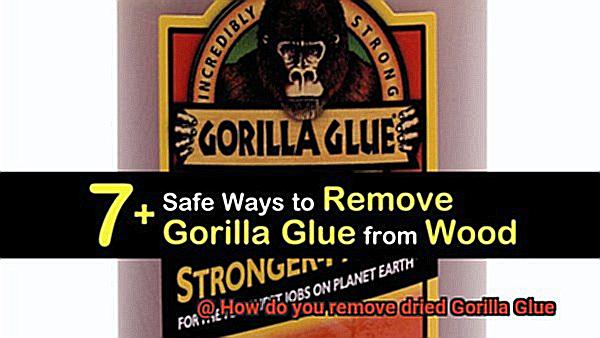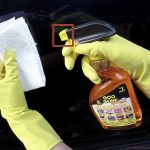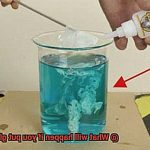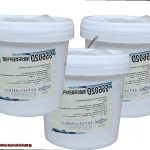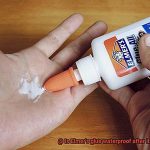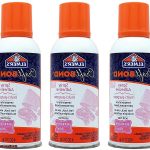Have you ever found yourself in a sticky situation, quite literally, with dried Gorilla Glue on your clothes or surfaces? It can be frustrating and overwhelming to figure out how to remove it without causing more damage. But don’t worry, we’ve got you covered.
In this informative blog post, we’ll guide you through the process of removing dried Gorilla Glue and saving your precious belongings from being permanently glued together.
Gorilla Glue is a powerful adhesive that’s widely used for various purposes. It’s known for its strong bonding properties and is commonly used in construction, arts and crafts, and household repairs. However, accidents happen, and when Gorilla Glue dries up, it can leave behind an unsightly stain that seems impossible to remove.
So, how do you tackle dried Gorilla Glue stains? There are several methods available depending on the surface or material it has stuck to. From using acetone to sanding it off or even freezing it, we’ll provide you with detailed instructions on each method so that you can choose the best one for your particular situation.
However, before diving into the removal process itself, we’ll also give you some helpful tips and precautions to take when removing dried Gorilla Glue. This will ensure that you don’t accidentally damage the surface or material in the process.
So if you’re ready to learn about the different techniques for removing dried Gorilla Glue like a pro, keep reading. We promise that by the end of this post, you’ll have all the knowledge and confidence needed to tackle any Gorilla Glue mess with ease.
What Is Gorilla Glue?
Contents
Gorilla Glue is more than just a household name, it’s a powerful and versatile adhesive that has earned a reputation for its strength and durability. This polyurethane-based adhesive is made up of a unique combination of chemicals that create a bond so strong, it’s perfect for woodworking projects, home repairs, and DIY projects.
One of the key features of Gorilla Glue is its ability to expand as it dries. This allows the adhesive to penetrate into small crevices and create a stronger bond. However, this same feature can cause problems if the glue is not used properly or if it gets on unintended surfaces.
It’s important to note that once Gorilla Glue has dried, it cannot be removed with water as it is not water-soluble. Removing dried Gorilla Glue requires patience and careful attention, but don’t worry, we’ve got you covered with some tips and techniques.
Acetone is one of the best ways to remove dried Gorilla Glue. However, before using acetone, it’s essential to test it on a small, inconspicuous area to ensure that it doesn’t damage the surface. Once you have confirmed that acetone is safe to use, apply a generous amount of acetone to the affected area using a clean cloth or sponge. Let the acetone soak into the glue for several minutes before attempting to remove it.
If you’re dealing with hard surfaces such as metal or wood, sandpaper or a scraper may be your best bet. Use a coarse grit sandpaper or scraper to gently sand away the glue until it’s completely removed. Work slowly and carefully to avoid damaging the surface underneath.
In some cases, heat can also be used to soften dried Gorilla Glue and make it easier to remove. Use a heat gun or hair dryer on high heat and direct it at the affected area for several minutes. Once the glue has softened, you can use a scraper or sandpaper to gently remove it.
Why Act Quickly When Removing Gorilla Glue?
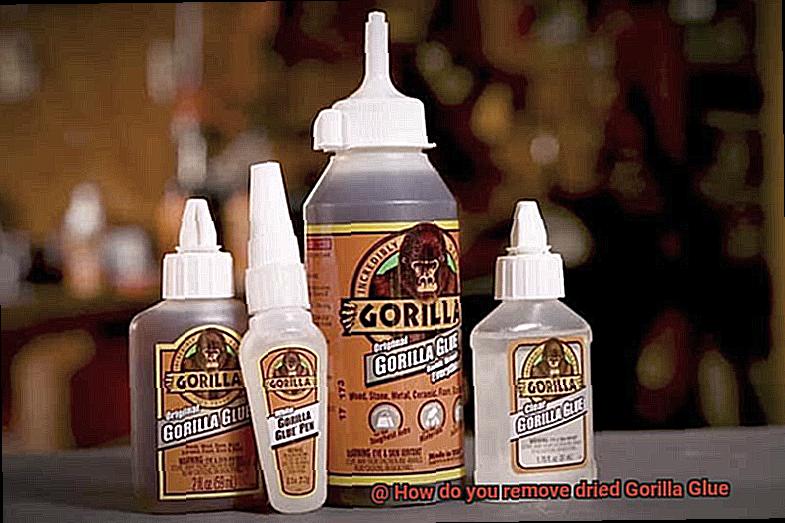
When it comes to removing Gorilla Glue, it’s crucial to act fast. Why? Because this adhesive dries at lightning speed, making it incredibly challenging to remove once it has hardened. In fact, if you let the glue dry completely, it may be impossible to remove without damaging the surface it’s stuck to.
The secret behind Gorilla Glue’s speedy drying process is its chemical composition. It contains polyurethane, which reacts with moisture in the air to create an unyielding bond. Once the glue comes into contact with moisture, it expands and hardens rapidly, making it a real headache to remove.
That’s why time is of the essence when dealing with Gorilla Glue. If you notice any excess glue on a surface, don’t hesitate. Remove it right away before it has a chance to dry and harden. Using a damp cloth or sponge is your best bet as water can help break down the glue and make it easier to remove.
But that’s not all. Dried Gorilla Glue can also cause damage to surfaces. For example, if it’s stuck to a wooden surface, you could end up splintering or damaging the wood if you try to remove it forcefully. That’s why gentle methods are essential when removing dried Gorilla Glue – you don’t want to cause any unnecessary harm.
How to Remove Dried Gorilla Glue Using Acetone
Don’t worry, acetone is here to the rescue. Acetone is a powerful solvent that can dissolve even the toughest adhesives without damaging your surfaces. However, it’s important to use it with caution as it can also cause harm to certain materials like plastic and painted surfaces. Let’s explore how to safely use acetone to remove dried Gorilla Glue in five simple steps.
Step 1: Gather Your Supplies
The first step is to gather all the necessary supplies before you begin. You’ll need acetone, a clean cloth or rag, gloves to protect your hands, and a plastic scraper or putty knife.
Step 2: Apply Acetone
Put on your gloves to protect your skin from the acetone. Then apply a small amount of acetone onto the glue using the cloth or rag. Allow the acetone to sit on the glue for a few minutes.
Step 3: Gently Scrape off the Glue
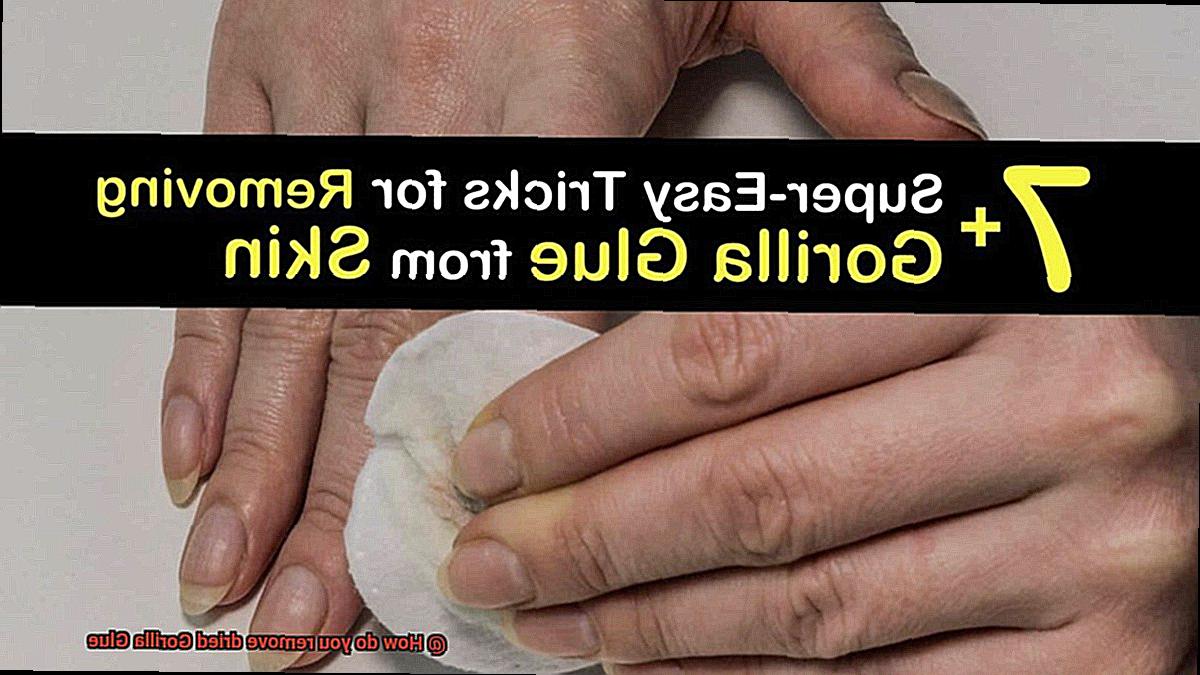
After a few minutes, gently scrape off the glue with a plastic scraper or putty knife. Be careful not to damage the surface underneath.
Step 4: Soak if Needed
If the glue is being stubborn, you can soak the affected area in acetone for several minutes before attempting to scrape it off. However, be sure to monitor the area closely to ensure that the acetone doesn’t damage the surface underneath.
Step 5: Wipe and Rinse
Once you’ve removed as much of the glue as possible, use a clean cloth or rag dipped in acetone to wipe away any remaining residue. Be sure to rinse the area thoroughly with water once you’re done to remove any traces of acetone.
Remember, acetone is highly flammable and can cause skin irritation. So, handle it with care and work in a well-ventilated area. Also, avoid using acetone on certain surfaces like painted or varnished surfaces as it can damage the finish. Always test a small, inconspicuous area first before using acetone on any surface.
Other Options for Removing Dried Gorilla Glue
In the previous section, we learned about using acetone to dissolve and remove the tough adhesive. However, depending on the surface or situation, acetone may not be the best option. That’s where alternative methods come in handy – let’s explore some.
One effective alternative method for removing dried Gorilla Glue is using hot water and dish soap. By soaking the affected area in hot water mixed with dish soap, you can break down the glue and make it easier to remove. After a few hours of soaking, use a soft-bristled brush to scrub off the glue. This method is gentle enough for most surfaces and equipment.

If you’re dealing with an especially stubborn spot of dried Gorilla Glue, try using white vinegar or lemon juice. Both contain acidic properties that can dissolve the glue. Simply apply the vinegar or lemon juice to the affected area and let it sit for a few minutes before wiping it away with a clean cloth or sponge. This natural solution works great on surfaces that can’t handle harsh chemicals.
For tougher surfaces like metal, plastic, or glass, rubbing alcohol or nail polish remover can be used. These options contain acetone but are less harsh than pure acetone and can be used without causing damage. Apply the rubbing alcohol or nail polish remover to a clean cloth and gently rub away the dried glue. This method is perfect for surfaces that require a little more elbow grease.
In some cases, using a heat gun or hairdryer can soften the glue enough to scrape it away with a plastic scraper or putty knife. However, caution must be taken when using heat as it can cause damage to some surfaces and equipment. This method is best used on surfaces that can handle high heat.
Heat as an Option for Softening Dried Gorilla Glue

There’s a simple and effective solution: heat. As an expert on this topic, I’m here to share my knowledge and help you through the process.
So why does heat work? It’s because high temperatures break down the chemical bonds in the glue, making it more pliable and easier to remove. And there are different ways to apply heat, such as using a heat gun, a hair dryer, or an oven.
If you choose to use a heat gun or hair dryer, it’s important to keep the heat source at least six inches away from the glued area to prevent any potential surface damage. Just apply the heat in a back and forth motion until the glue starts to soften. Once you’ve achieved this, use a scraper or sandpaper to remove the glue.
Alternatively, if you prefer using an oven, preheat it to 200 degrees Fahrenheit, then place the glued object inside for 10-15 minutes. Check frequently and remove once the glue has softened. Again, use a scraper or sandpaper to remove any remaining glue.
However, caution is key when applying heat. Excessive temperatures can cause damage to certain surfaces, so make sure to test a small area first before applying heat. And always wear protective gloves and eyewear when handling heated objects.
Tips and Techniques for Safely Removing Dried Gorilla Glue
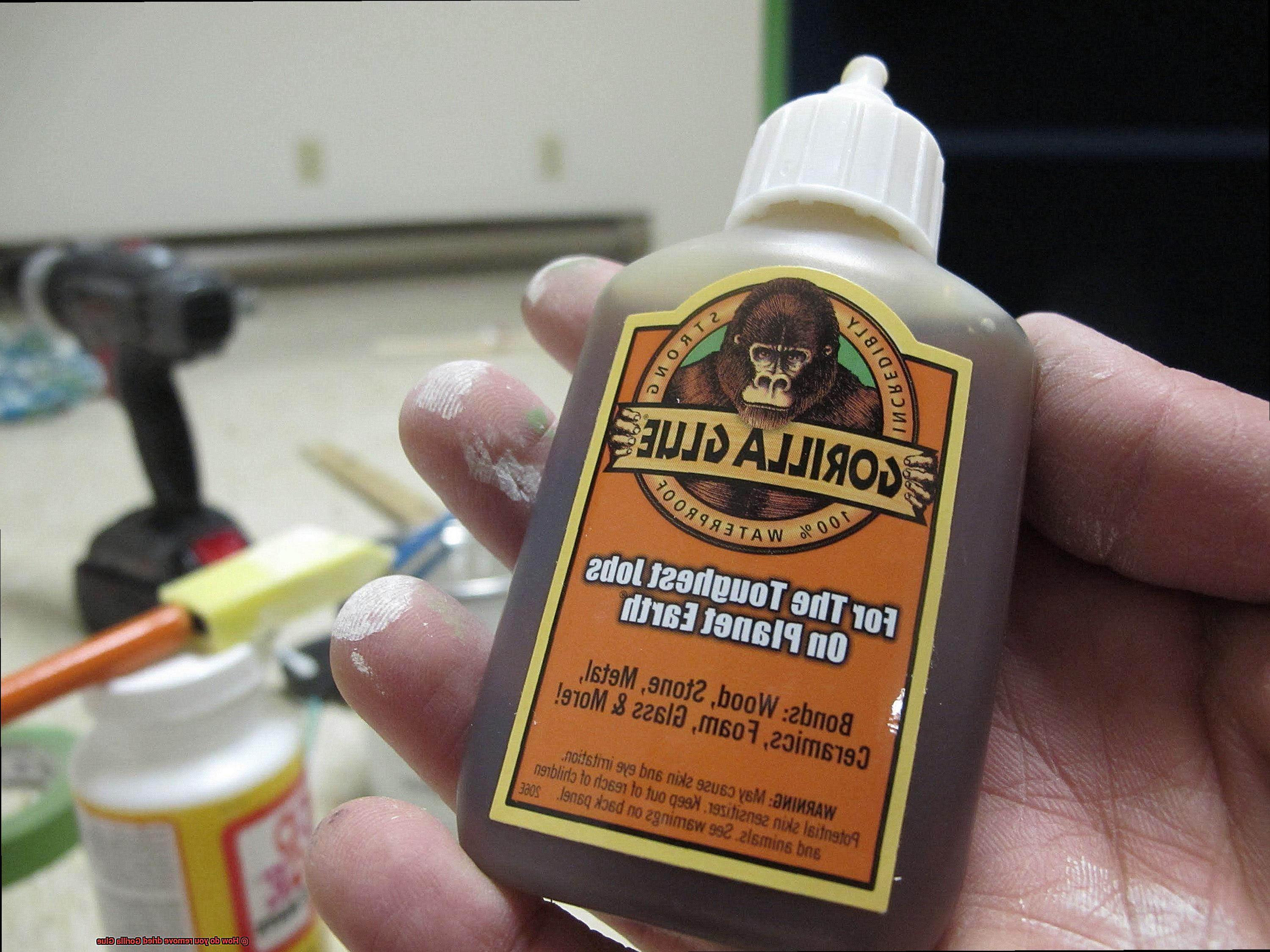
Removing dried Gorilla Glue can be a real nightmare, but it doesn’t have to be. Whether it’s on wood, metal, fabric, or any other surface, we’ve got you covered with these five tips and techniques for safely removing dried Gorilla Glue.
Acetone
This powerful solvent is great for dissolving dried Gorilla Glue, but be careful as it can damage some surfaces. Always test on a small area first. Apply acetone to the affected area, let it sit for a few minutes, and then use a plastic scraper or credit card to scrape away the glue.
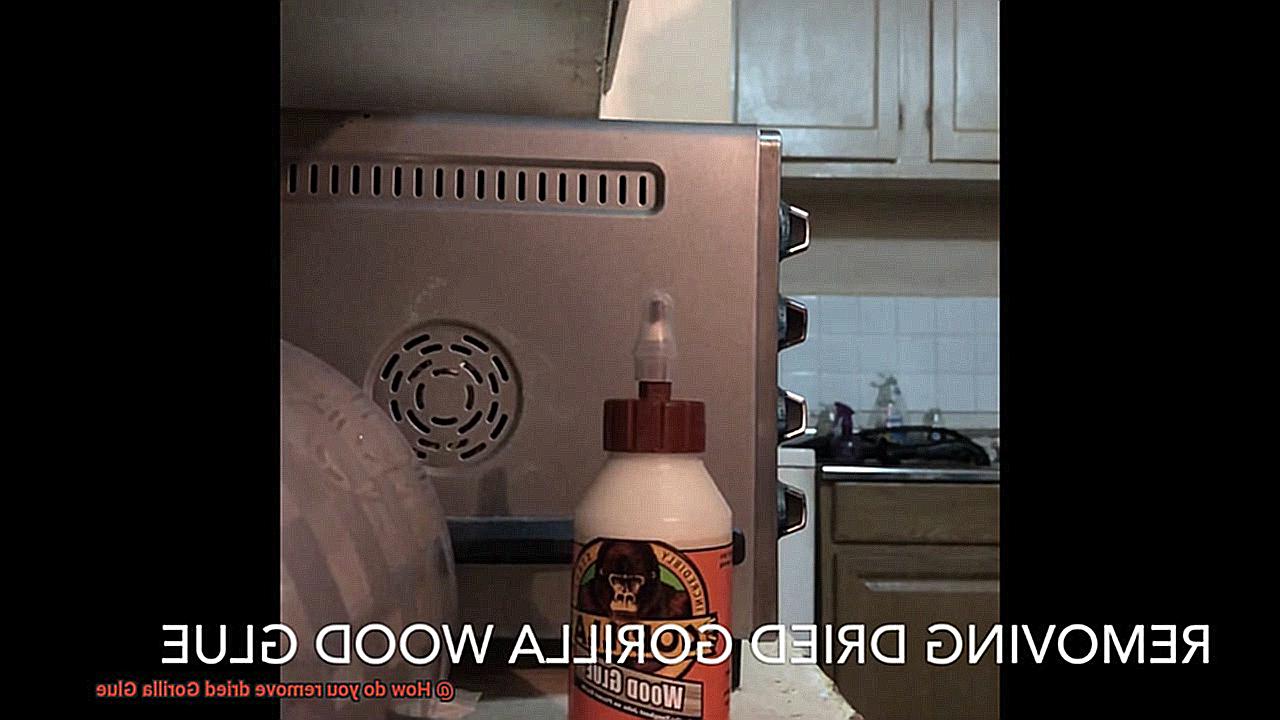
Sandpaper
For surfaces like wood or metal, sandpaper is a great option. Use a fine-grit sandpaper and sand in a circular motion until the glue is removed. But don’t sand too hard or too long as it may damage the surface.
Heat
Heat can soften dried Gorilla Glue, making it easier to remove. Use a hairdryer or heat gun to apply heat to the glue for several minutes. Once the glue softens, use a plastic scraper or credit card to scrape it away.
Vinegar
Vinegar is another household item that can dissolve Gorilla Glue. Soak a cloth in vinegar and place it over the dried glue. Let it sit for about an hour before attempting to scrape away the glue with a plastic scraper or credit card.
Razor Blade
For flat surfaces like glass or ceramic, a razor blade can be used to scrape away the glue. Hold the blade at a 45-degree angle and carefully scrape away the glue. Use a new blade to avoid scratching the surface.
Remember to always wear gloves and protective eyewear when attempting to remove dried Gorilla Glue as some of these techniques involve harsh chemicals or tools that can be dangerous if not used properly. Also, test any of these techniques on a small, inconspicuous area first to ensure that it does not damage the surface.
It’s important to note that Gorilla Glue is a polyurethane-based adhesive, which means traditional solvents like acetone or nail polish remover won’t work. In fact, using these solvents can actually make the glue bond stronger.
One safe and effective method for removing dried Gorilla Glue is to use a combination of heat and mechanical force. This involves using a hairdryer or heat gun to apply heat to the glue, which will soften it and make it easier to remove. Once the glue has been heated, it can be scraped away using a plastic scraper or credit card. Avoid using metal scrapers as they can scratch or damage the surface.
QYmZSDjLQ9A” >
Conclusion
To sum it up, removing dried Gorilla Glue can seem like a daunting task, but fear not. With the right methods and precautions, you can safely and effectively remove it. Gorilla Glue is infamous for its strong bonding properties, making it a challenge to remove once it has dried up. However, there are several techniques available depending on the material or surface it has adhered to.
Acetone is one of the best options for removing dried Gorilla Glue, but make sure to test it on a small area first before using it. For hard surfaces like metal or wood, sandpaper or a scraper may be the way to go. Heat can also be used to soften dried Gorilla Glue and make removal easier.
Time is of the essence when dealing with Gorilla Glue as it dries quickly and can cause damage if left unattended. Always take precautions when removing dried Gorilla Glue, such as wearing gloves and protective eyewear.
Other alternative methods include using hot water and dish soap, white vinegar or lemon juice, rubbing alcohol or nail polish remover, and utilizing a heat gun or hairdryer.
In conclusion, by following these tips and techniques for safely removing dried Gorilla Glue, you’ll have all the knowledge needed to tackle any sticky situation with ease.

